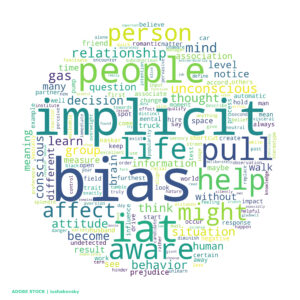‘Why Don’t We Have a Representative Workforce?’ & Other Questions: How Implicit Bias Affects Medicine
Editor’s note: ACR on Air, the official podcast of the ACR, dives into topics important to the rheumatology community, such as the latest research, solutions for practice management issues, legislative policies, patient care and more. Twice a month, host Jonathan Hausmann, MD, a pediatric and adult rheumatologist in Boston, interviews clinicians and rheumatology professionals on important topics in rheumatology. In a series for The Rheumatologist, we provide highlights from these relevant conversations. Listen to the podcast online at acronair.org, or download and subscribe to ACR on Air wherever you get your podcasts. Here we highlight episode 34, “Responding to and Dealing with Implicit Bias as a Healthcare Provider,” which aired on Aug. 2, 2022.

How much does implicit bias affect the decisions rheumatologists and other physicians make with their patients? An episode of ACR On Air explored implicit bias with researcher and author Arin Reeves, JD, PhD, founder and managing director of Nextions, a Chicago-based firm focused on workplace culture change.
Defining Implicit Bias
Dr. Reeves explained that biases are essentially shortcuts in our brains to understand life. Biases are different from instincts because biases are learned. Influences from family, TV and other media and religious beliefs all contribute to our biases. Those biases are then used at home, school and the workplace.
Over time, we may learn to respond to spiders as scary or flowers as pretty. In the same vein, we develop unconscious assumptions about people, Dr. Reeves says. Example: Many people may think of women as nurturing and men as strong.
She clarifies that implicit biases aren’t intentionally meant to exclude others, but they can influence our decisions without us realizing it. This definition is in contrast with explicit bias, when people are aware of their prejudices and attitudes toward certain groups and want to hurt or discriminate against others based on their prejudicial views.
Within medicine, implicit associations can influence decisions made during patient care. “When you are in a position to make decisions [that] influence or impact other people’s lives, that’s where the bias creates inequities, disparities and other things,” says Dr. Reeves.
Status Quo & Other Biases
One form of implicit bias is status quo bias, which Dr. Reeves describes as following a pattern because it has been the norm. Example: At a hospital, it could involve hiring a white man instead of a Latinx woman because that is who has traditionally been hired.

Dr. Reeves
Another common bias in medicine is related to assumptions about who is a good fit for certain specialties. Example: The specialty of pediatrics is typically associated with someone who is good with kids and nurturing. This understanding may lead many people to associate women with the field of pediatrics.
Status quo bias may affect who you traditionally see as a physician in a certain specialty. Dr. Reeves says, “But when you go back one or two steps, you [should] ask, ‘What role did bias play in why the [hiring] pool looks like it does?’”
Even when hospital leaders examine overall physician demographics, those demographics may look diverse. In those cases, Dr. Reeves encourages hospital leaders to break down those demographics by specialty because they will usually find clusters.
To tackle better representation, Dr. Reeves likes to ask: “Why don’t we have a representative workforce?” instead of “Do we want a diverse workforce?” She believes the former question leads to a better examination of structural inequities, such as access to college, access to medical school, medical school cost and other issues.
A diverse workforce for an organization, hospital or healthcare system will help enrich its understanding of disease and allow everyone to take better care of patients, Dr. Hausmann says.
Dr. Reeves also notes the importance of a diverse workforce within medicine so that patients can relate to their providers, which may potentially increase patient satisfaction and treatment adherence.
Understanding Patient Pain
One area specific to rheumatology Dr. Hausmann and Dr. Reeves discussed was the perception of pain by doctors and how it relates to implicit bias. Dr. Reeves gave the example of women of color—especially those from immigrant backgrounds—who refuse to say they are in pain, even if they are currently hurting.

Dr. Hausmann
More follow-up questions, such as, “Are you in pain, and you’re just putting up with it? Or are you not in pain?” may help pinpoint what’s really happening. This probing can help determine what’s going on beyond what a patient says initially, enabling physicians to accurately tailor treatments. This approach is in contrast to making assumptions about pain based solely on a patient’s initial comments or actions.
Dr. Reeves recalls her own perception of pain based on her parents, both of whom were immigrants and physicians. They insisted that she go to school even if she wasn’t feeling well. They would say, “Can you stand? Are you bleeding? If you can stand and you’re not bleeding, go to school.”
Although she now realizes that approach can be an unhealthy way to look at pain, she catches herself in this same thought pattern. Now that she is aware of that pattern, she can focus on finding out what’s wrong when someone says they are in pain.
“The interruption of implicit bias is understanding those thoughts and saying, ‘I can choose behavior that is different than my initial thought,’” she says.
When physicians are not able to step back and critically examine conclusions they’ve made, it can lead to very different care decisions. Dr. Reeves explains that this is when disparities occur. She also acknowledges that a reliance on unconscious associations is easy to do in today’s busy clinical practice.
Tapping into Experience
Dr. Reeves notes that using previous experience to reach a conclusion faster than someone seeing it for the first time is still a legitimate skill in the workplace. “You have to get better at asking, ‘Is that an instinct, or could I have overlooked something because I got to the conclusion too soon?’” she says. “You want [a physician] who has experience and who can thin-slice their way to a faster decision, but who [also] has just enough awareness to question themselves and double check their conclusion.”
Even while using previous experience to make care conclusions or recommendations, physicians can take a little bit of extra time to question their initial assumptions, Dr. Hausmann says.
Don’t get nervous about the time involved with this questioning because you can quickly habituate. “When you do it constantly, it doesn’t take a lot of time,” Dr. Reeves explains.
One practice: Dr. Reeves does not discount aberrations, which may provide insightful information. One technique she advises is to reach a conclusion, return to the aberrations and ask, “If the aberration was actually a symptom and I put it back in here, would that change [my conclusions]?”
Inclusion in Clinical Trials
When asked about implicit bias in research, Dr. Reeves pointed to historical evidence of medical research associated with experiments on people of color that may lead them to be more skeptical of research participation.
A way to help overcome this reluctance is to put people on the research team who can communicate with these under-represented communities and be someone who they can trust.
“That doesn’t always have to be the lead researcher or physician,” Dr. Reeves says. Interns, social workers, psychologists and other care workers can assist with making these connections.
An excellent way to address bias in research and elsewhere in medicine is the use of checklists that include action items, such as meaningfully incorporating people of diverse racial or ethnic backgrounds or other related components. This can keep research team members and clinicians alert to the possibility of implicit bias on their part and that of potential research subjects.
“Otherwise, you’re only going to ask the questions you already know the answers to. If you have a list in front of you, something’s going to surprise you because you have followed that checklist,” Dr. Reeves says.
Vanessa Caceres is a medical writer in Bradenton, Fla.



